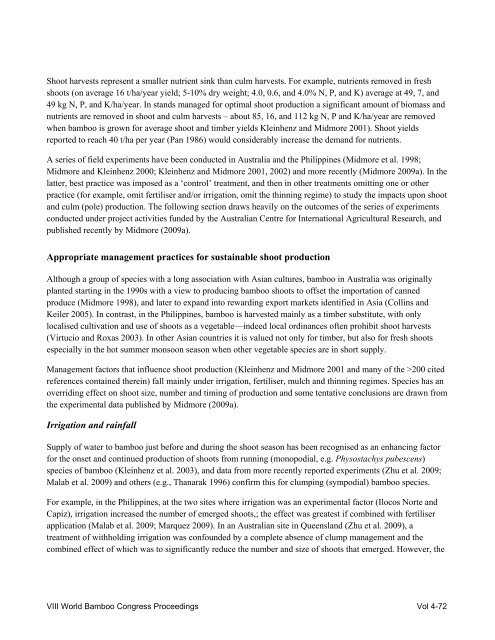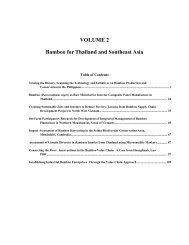WBC-VIII-Vol.4 – Resources – Forestry, Plantations and ... - BambuSC
WBC-VIII-Vol.4 – Resources – Forestry, Plantations and ... - BambuSC
WBC-VIII-Vol.4 – Resources – Forestry, Plantations and ... - BambuSC
You also want an ePaper? Increase the reach of your titles
YUMPU automatically turns print PDFs into web optimized ePapers that Google loves.
Shoot harvests represent a smaller nutrient sink than culm harvests. For example, nutrients removed in fresh<br />
shoots (on average 16 t/ha/year yield; 5-10% dry weight; 4.0, 0.6, <strong>and</strong> 4.0% N, P, <strong>and</strong> K) average at 49, 7, <strong>and</strong><br />
49 kg N, P, <strong>and</strong> K/ha/year. In st<strong>and</strong>s managed for optimal shoot production a significant amount of biomass <strong>and</strong><br />
nutrients are removed in shoot <strong>and</strong> culm harvests <strong>–</strong> about 85, 16, <strong>and</strong> 112 kg N, P <strong>and</strong> K/ha/year are removed<br />
when bamboo is grown for average shoot <strong>and</strong> timber yields Kleinhenz <strong>and</strong> Midmore 2001). Shoot yields<br />
reported to reach 40 t/ha per year (Pan 1986) would considerably increase the dem<strong>and</strong> for nutrients.<br />
A series of field experiments have been conducted in Australia <strong>and</strong> the Philippines (Midmore et al. 1998;<br />
Midmore <strong>and</strong> Kleinhenz 2000; Kleinhenz <strong>and</strong> Midmore 2001, 2002) <strong>and</strong> more recently (Midmore 2009a). In the<br />
latter, best practice was imposed as a ‘control’ treatment, <strong>and</strong> then in other treatments omitting one or other<br />
practice (for example, omit fertiliser <strong>and</strong>/or irrigation, omit the thinning regime) to study the impacts upon shoot<br />
<strong>and</strong> culm (pole) production. The following section draws heavily on the outcomes of the series of experiments<br />
conducted under project activities funded by the Australian Centre for International Agricultural Research, <strong>and</strong><br />
published recently by Midmore (2009a).<br />
Appropriate management practices for sustainable shoot production<br />
Although a group of species with a long association with Asian cultures, bamboo in Australia was originally<br />
planted starting in the 1990s with a view to producing bamboo shoots to offset the importation of canned<br />
produce (Midmore 1998), <strong>and</strong> later to exp<strong>and</strong> into rewarding export markets identified in Asia (Collins <strong>and</strong><br />
Keiler 2005). In contrast, in the Philippines, bamboo is harvested mainly as a timber substitute, with only<br />
localised cultivation <strong>and</strong> use of shoots as a vegetable—indeed local ordinances often prohibit shoot harvests<br />
(Virtucio <strong>and</strong> Roxas 2003). In other Asian countries it is valued not only for timber, but also for fresh shoots<br />
especially in the hot summer monsoon season when other vegetable species are in short supply.<br />
Management factors that influence shoot production (Kleinhenz <strong>and</strong> Midmore 2001 <strong>and</strong> many of the >200 cited<br />
references contained therein) fall mainly under irrigation, fertiliser, mulch <strong>and</strong> thinning regimes. Species has an<br />
overriding effect on shoot size, number <strong>and</strong> timing of production <strong>and</strong> some tentative conclusions are drawn from<br />
the experimental data published by Midmore (2009a).<br />
Irrigation <strong>and</strong> rainfall<br />
Supply of water to bamboo just before <strong>and</strong> during the shoot season has been recognised as an enhancing factor<br />
for the onset <strong>and</strong> continued production of shoots from running (monopodial, e.g. Physostachys pubescens)<br />
species of bamboo (Kleinhenz et al. 2003), <strong>and</strong> data from more recently reported experiments (Zhu et al. 2009;<br />
Malab et al. 2009) <strong>and</strong> others (e.g., Thanarak 1996) confirm this for clumping (sympodial) bamboo species.<br />
For example, in the Philippines, at the two sites where irrigation was an experimental factor (Ilocos Norte <strong>and</strong><br />
Capiz), irrigation increased the number of emerged shoots,; the effect was greatest if combined with fertiliser<br />
application (Malab et al. 2009; Marquez 2009). In an Australian site in Queensl<strong>and</strong> (Zhu et al. 2009), a<br />
treatment of withholding irrigation was confounded by a complete absence of clump management <strong>and</strong> the<br />
combined effect of which was to significantly reduce the number <strong>and</strong> size of shoots that emerged. However, the<br />
<strong>VIII</strong> World Bamboo Congress Proceedings Vol 4-72




